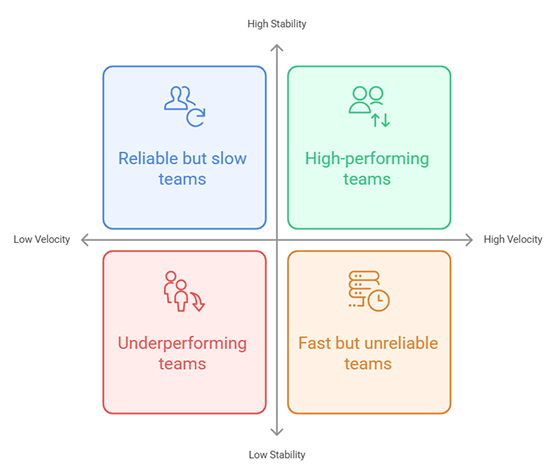In modern software engineering, software development teams are challenged by velocity and quality.
If you’re shipping a product live in 2025, you need to make sure that it is trustworthy and can be improved with incremental updates.
To do so, you’d need to track some type of metric. Well, this is where accelerate metrics come into play. Accelerate metrics help provide an accurate measurement of accelerate software development and operational excellence that distinguishes industry leaders from the pack.
What are accelerate metrics (DORA Metrics)?
Accelerate and DORA metrics are interchangeable terms that refer to the same set of key performance indicators (KPIs) used in software development.
Simply put, accelerate metrics show how efficiently and effectively a company can develop and deliver software.
The accelerate metrics consist of 4 key metrics:
- Deployment frequency
- Lead time for changes
- Mean time to recovery
- Change failure rate
What are the four key accelerate metrics?
Deployment frequency
This metric measures how often an organization successfully releases software to production. High-performing teams deploy more frequently, allowing them to iterate faster and respond quickly to market changes and customer needs.
Lead time for changes
This defines the time it takes from committing code to deploying it in production. Shorter lead times indicate a more efficient development process and a responsive engineering team.
Mean time to recovery (MTTR)
This metric measures how quickly a team can restore a service after an incident in production. It highlights the resilience of software systems and the team’s preparedness and effectiveness in handling failures.
Change failure rate
This measures the percentage of deployments that cause failures in production. A lower change failure rate indicates higher-quality software and robust deployment practices. It shows a team’s ability to introduce new features or changes without disrupting existing services.
Team performance vs. key accelerate metrics
The four accelerate metrics discussed above fall under two categories as follows:
- Velocity metrics
- Deployment frequency
- Lead time for changes
- Stability metrics
- Mean time to recovery
- Change failure rate
When you consider team performance, the following graph shows the kinds of teams according to the stability and velocity of tasks.

The importance of accelerate metrics
It’s important to use accelerate metrics when you’re building software. Here are some top reasons as to why you should consider using them:
- Benchmarking performance: Teams can compare their performance against industry standards and high-performing organizations.
- Understanding development practices: Regularly measuring these metrics helps pinpoint ineffective practices and areas where the development process may lag, leading to the adoption of best practices.
- Enhancing customer satisfaction: Frequent deployments and quick failure recovery demonstrate continuous optimization of customer-facing services, leading to higher customer satisfaction.
- Driving business outcomes: There is a strong correlation between software delivery performance and business performance. Organizations with superior delivery capabilities often experience better market share due to their ability to adapt quickly to market demands and customer needs.
A use case of accelerate metrics
Implementing accelerate metrics requires careful integration into existing workflows to avoid disrupting team dynamics or compromising quality.
Here are some practical ways to apply these metrics:
- By integrating with tools and technology: Organizations often use sophisticated tooling and dashboard technologies to track these metrics effectively. Using CI/CD in projects is a common example of integrating tools and technologies.
- Cultural impact: Focusing on improving these metrics fosters a culture of excellence and continuous improvement among software development teams. It encourages a mindset oriented toward high-quality code, frequent feedback, and proactive problem-solving. One example is using Agile methodologies.
- Strategic implementation: For these metrics to be impactful, engineering leaders should implement them strategically. This involves deploying the appropriate tooling and ensuring that all levels of the organization understand and support the goals associated with these metrics. Leadership is crucial in setting expectations and aligning the organization toward these objectives.
Accelerate metrics can’t be used to check developer productivity. If you need to check the dev productivity, go for a framework like the SPACE metric.
Concluding thoughts
Any organization that is serious about driving innovation and customer satisfaction in software development must have accelerate metrics. By incorporating these metrics, businesses can benchmark performance, comprehend and enhance development practices, improve customer satisfaction, and achieve business goals.
Additionally, organizations should consider implementing accelerate metrics in order to obtain a more comprehensive understanding of developer productivity.
